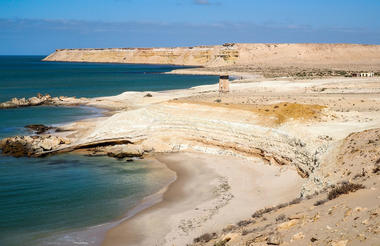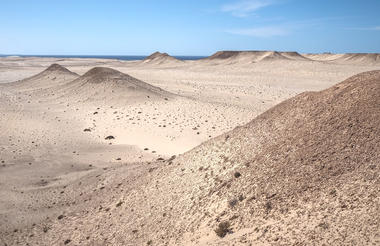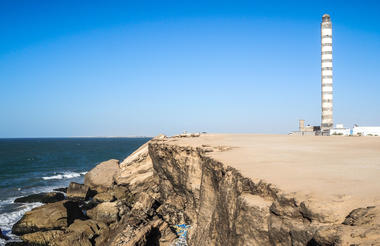An exotic fusion of Southern Mediterranean, Arabic and African influences, Morocco is an enticing combination of ancient cities and Roman ruins, sweeping deserts and centuries-old medinas, mosques and minarets, winding alleyways and vibrant markets, gorgeous beaches and rugged mountains. The Imperial Cities of Fes, Marrakech, Meknes and Rabat have all had a stint as the national capital and are liberally studded with attractions, including a plethora of ancient architecture, museums and souks (markets). The coastal city of Casablanca boasts one of the largest mosques in the world, while Tangier, on the Mediterranean coast, features some beautiful bays and sandy coves. Visitors can look forward to sampling exotic Berber cuisine, sipping on a fresh cup of coffee or a mint tea at a streetside cafe, hike Toubkal - North Africa’s highest peak or enjoy camel trekking in the desert.
Situated to the north of the foothills of the snow-capped Atlas Mountains and fringing the famed Sahara, the bustling UNESCO-listed city of Marrakesh is an enchanting travel destination. Marrakesh is also home to the largest traditional Berber market in Morocco and one of the busiest squares in the world, known as Djemaa el Fna. Don’t miss the opportunity to visit this square in the evening as it transforms into an enormous, open-air restaurant, and browse through exquisite carpets, spices and a myriad of other items. Art, design and architecture enthusiasts flock to the city to see its incredible artisan achievements, so beautifully expressed at the glorious Bahia Palace, Dar Si Said and Saadian Tombs, as well as at several museums. The other-worldly Jardin Majorelle is also unmissable.



Carved by the Dadès River in Morocco's High Atlas Mountains, the Dadès Gorges are deep canyons with steep walls lined with cedar trees and verdant vegetation. Springs feed groves of palm and almond trees, while irrigation sustains fields of wheat, fig, almond, and olive orchards. Located in Ouarzazate and Errachidia provinces, the highest point is 3 000 metres above sea level, narrowing to just two metres wide. A haven for hikers, climbers, and adventurers, the area offers opportunities for trekking and rock climbing, with caves for spelunking. Encounter breathtaking rock formations showcasing hues from tan to rust red, accessible via the Road of a Thousand Kasbahs. Historic kasbahs and Berber villages overlook the valley, some converted into boutique hotels. The area teems with wildlife like ibexes, Barbary macaques, and birds of prey.



One of Africa’s driest and lowest-lying countries, Western Sahara is located in North West Africa, bordering the North Atlantic Sea. The nation is a disputed territory, with both Morocco and pro-independence groups laying claim to its desert landscapes - and more specifically its rich natural reserves. Politics aside, Western Sahara has some spectacular tourist attractions. The glittering jewel in its crown is Dakhla, a picture-perfect coastal city that offers superb kite-surfing, windsurfing and fishing. On either side of Dakhla, idyllic beaches stretch for miles along the oceanfront, while inland lies the stony desert and blush-coloured Saharan sand dunes. Culturally, the country is an intricate and beguiling mix of Berber, Arab and African culture, and the rare travellers that do visit can look forward to warm hospitality - a trademark quality of the local people.
One of Africa’s driest and lowest-lying countries, Western Sahara is located in North West Africa, bordering the North Atlantic Sea. The nation is a disputed territory, with both Morocco and pro-independence groups laying claim to its desert landscapes - and more specifically its rich natural reserves. Politics aside, Western Sahara has some spectacular tourist attractions. The glittering jewel in its crown is Dakhla, a picture-perfect coastal city that offers superb kite-surfing, windsurfing and fishing. On either side of Dakhla, idyllic beaches stretch for miles along the oceanfront, while inland lies the stony desert and blush-coloured Saharan sand dunes. Culturally, the country is an intricate and beguiling mix of Berber, Arab and African culture, and the rare travellers that do visit can look forward to warm hospitality - a trademark quality of the local people.



An exotic fusion of Southern Mediterranean, Arabic and African influences, Morocco is an enticing combination of ancient cities and Roman ruins, sweeping deserts and centuries-old medinas, mosques and minarets, winding alleyways and vibrant markets, gorgeous beaches and rugged mountains. The Imperial Cities of Fes, Marrakech, Meknes and Rabat have all had a stint as the national capital and are liberally studded with attractions, including a plethora of ancient architecture, museums and souks (markets). The coastal city of Casablanca boasts one of the largest mosques in the world, while Tangier, on the Mediterranean coast, features some beautiful bays and sandy coves. Visitors can look forward to sampling exotic Berber cuisine, sipping on a fresh cup of coffee or a mint tea at a streetside cafe, hike Toubkal - North Africa’s highest peak or enjoy camel trekking in the desert.
Morocco’s second-largest city and the country’s former capital, Fes (Fez) is an exotic mix of Arabic architecture, ancient alleyways calls to prayer and colourful markets; all mixed in with a good dose of modern culture. Home to the venerated Karaouine Mosque, which dates back to 859 AD and incorporates an Islamic university, and to the country’s most hallowed shrine, the Zaouia Moulay Idriss II; Fes is regarded as the spiritual seat of Morocco. Music lovers should try to synchronise their trips with the annual Festival of Sacred Music, one of the highlights of the city’s cultural calendar showcasing diverse performances of spiritual and religious music; while those with a penchant for shopping can browse the mesmerizing colourful markets selling an exquisite array of silver, leather and other handicrafts up for grabs.



Casablanca lies on the Atlantic coast, in central-western Morocco. Fondly known by locals simply as ‘Casa', the capital is the industrial, economic and cultural heart of this remarkable country, as well as its most cosmopolitan, liberal, and progressive city. While most visitors overlook Casablanca in favour of Morocco’s more popular and exotic tourist areas, this sprawling metropolis has plenty to offer the discerning traveller and has many hidden historical and cultural gems just waiting to be discovered. The city is famous for its spectacular Art Deco and Moorish Revival architecture, constructed during the Colonial Period. Explore the Old Medina, a tiny, ancient, walled village; visit the impressive King Hassan II Mosque; discover the ornate rooms, masterfully tiled floors, and intricately carved wooden ceilings of the Hispanic-Moorish Mahkama du Pacha; or simply watch the world go by at one of the many ocean-view cafes along the waterfront boulevard.








